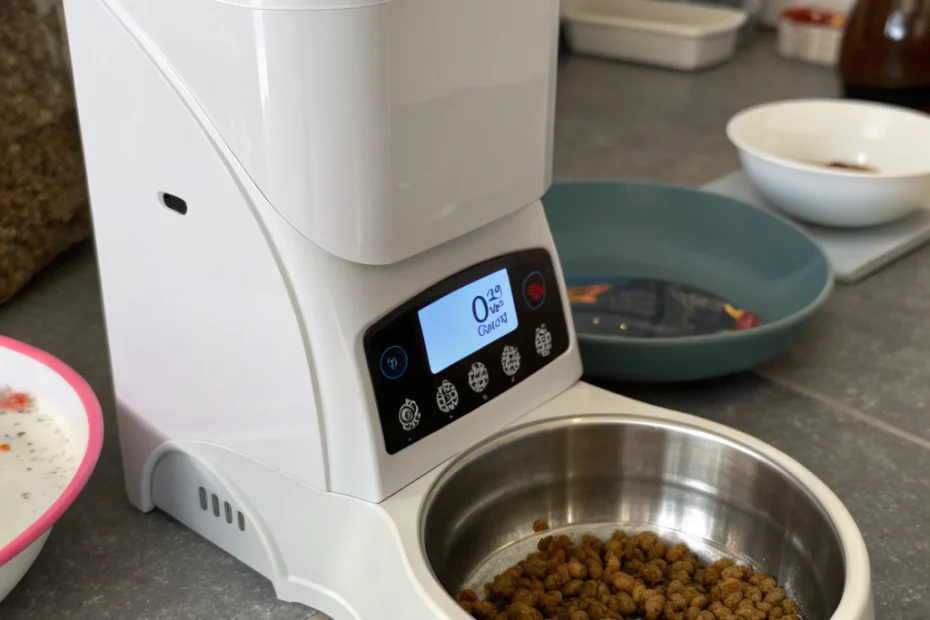At-a-Glance
Automatic cat feeders are a convenient solution for managing your cat’s feeding schedule. These devices can support consistent meal times, portion control, and even cater to your cat’s dietary needs. As part of the tech and smart accessories category, they offer features that may enhance your pet’s feeding experience. Whether you’re away from home or simply want to streamline feeding, automatic cat feeders can be a valuable addition to your cat care routine.
How to Choose
Choosing the right automatic cat feeder involves considering several factors. First, think about your cat’s dietary requirements. Some feeders are designed for dry food, while others can handle wet food. Consider the portion size and frequency settings to match your cat’s eating habits.
Next, evaluate the feeder’s capacity. If you have multiple cats or a larger breed, a feeder with a larger capacity may be necessary. Also, look for features like programmable timers, which can help maintain a consistent feeding schedule.
Consider the tech features available. Some feeders come with smartphone connectivity, allowing you to control feeding times remotely. This can be particularly useful if your schedule is unpredictable.
Safety & Setup
Setting up an automatic cat feeder safely is crucial. Begin by reading the manufacturer’s instructions thoroughly. Ensure that the feeder is placed on a stable surface to prevent tipping.
Check that all parts are securely assembled. If the feeder uses batteries, ensure they are fresh and properly installed. For feeders with electrical components, ensure cords are out of reach of your cat to prevent chewing.
Monitor your cat’s initial interactions with the feeder to ensure they are comfortable and not stressed by the new device. Gradually introduce the feeder by using it alongside their regular feeding routine until they are accustomed to it.
Core Pillars
The core pillars of using automatic cat feeders include convenience, consistency, and control. These devices offer convenience by automating feeding, reducing the need for manual intervention. Consistency is achieved through programmable settings that ensure your cat receives meals at the same time each day.
Control is another important aspect. Automatic feeders allow you to manage portion sizes and meal frequency, which can support weight management and prevent overfeeding. This is particularly beneficial for cats with specific dietary needs or those prone to obesity.
Placement & Environment Tips
Proper placement of your automatic cat feeder is essential for its effective use. Choose a quiet, low-traffic area where your cat feels comfortable eating. Avoid placing the feeder near litter boxes or in direct sunlight, as this can affect food quality.
Ensure the feeder is easily accessible to your cat but out of reach of other pets or children. If your home has multiple cats, consider separate feeding stations to prevent competition and ensure each cat receives the correct portion.
Regularly clean the feeder to maintain hygiene and prevent food contamination. Follow the manufacturer’s cleaning instructions to ensure all components are properly sanitized.
Comparison with Alternatives
When comparing automatic cat feeders to traditional feeding methods, consider the benefits and limitations. Manual feeding allows for direct interaction with your cat, which can strengthen your bond. However, it requires a consistent schedule and may not be feasible for busy owners.
Automatic feeders offer the advantage of flexibility and consistency, especially for those with unpredictable schedules. They can also help manage portion control more effectively than manual feeding.
Other alternatives include gravity feeders, which rely on gravity to dispense food as your cat eats. While simple, they lack the portion control and scheduling features of automatic feeders.
FAQs
Are automatic cat feeders suitable for all cats?
Automatic cat feeders can be suitable for most cats, but it’s important to consider your cat’s specific needs and habits. Cats with special dietary requirements or those prone to overeating may benefit from the portion control features of these devices.
Can automatic feeders handle wet food?
Some automatic feeders are designed to handle wet food, but not all. Check the product specifications to ensure compatibility with wet food if that’s your preference.
How do I maintain an automatic cat feeder?
Regular cleaning is essential to maintain an automatic cat feeder. Follow the manufacturer’s instructions for disassembly and cleaning. Ensure all parts are dry before reassembling to prevent mold or bacteria growth.
What to Do Next
Now that you have a better understanding of automatic cat feeders, consider your cat’s specific needs and lifestyle. Evaluate the features that would best support your feeding routine and enhance your cat’s well-being. Remember, while these devices offer convenience and control, they should complement your overall cat care strategy.
Disclaimer: Always consult your veterinarian for personalized advice regarding your cat’s health.
